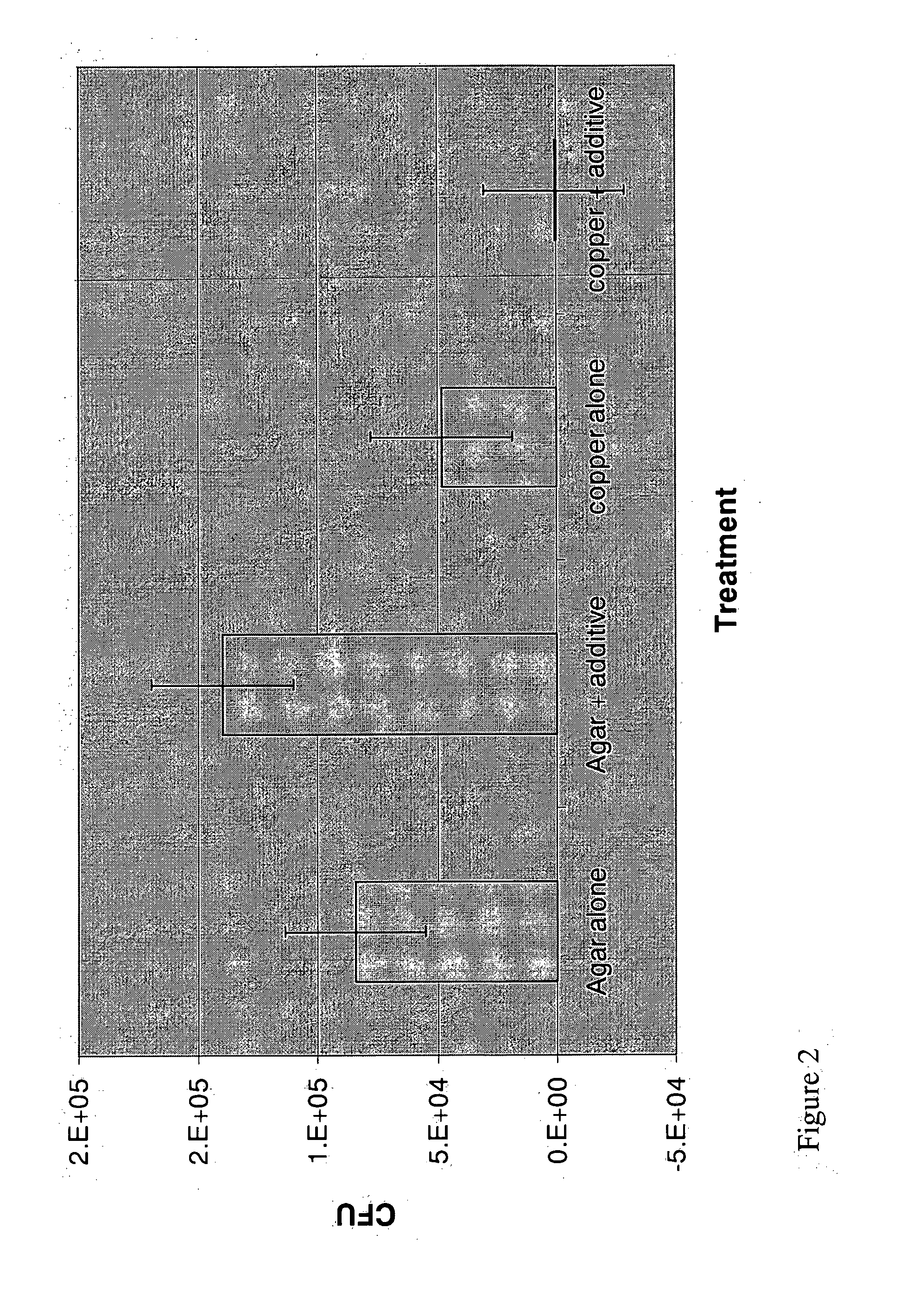Biofilm resistant materials
a biofilm and material technology, applied in the field of biofilm resistant materials, can solve the problems of bacterial biofilms, serious threats to human health, and decrease in heat transfer, and achieve the effect of increasing the concentration of ethanol
- Summary
- Abstract
- Description
- Claims
- Application Information
AI Technical Summary
Benefits of technology
Problems solved by technology
Method used
Image
Examples
example 1
Bacteriocidal Effects of Copper
Materials and Methods:
Primary Exposure:
[0083]Polypropylene plates with and without a hydrophilic additive served as controls. Where a hydrophilic additive was used the commercially available surfactant / lubricant Lurol in a 0.5% to 2% concentration was used. Polypropylene plates containing 5% Copper oxide (weight / weight) with and without the hydrophilic additive were prepared and 100 μl of saline containing approximately 105 CFU Escherichia coli ATCC #8739 were put on top of the plates.
Multiple Repetitive Exposures:
[0084]One hundred μl saline containing approximately 105 CFU bacteria were put on top of polypropylene plates (same plates as detailed above) and incubated in a moist chamber at 37° C. After 1 hour the 100 μl saline aliquot was removed and a fresh 100 μl aliquot of saline containing approximately 105 CFU bacteria were added on top of the polypropylene plates exactly at the same spot where the previous saline aliquot was placed. This was repea...
example 2
Effects of Copper on Biofilm Formation
[0086]In order to determine the effect of insoluble copper containing formulations on the presence or absence of a biofilm, the following assay was conducted: Polypropylene plates 0.4 cm×0.4 cm in size (with and without 5% Cu (w / w)) in duplicates were placed at the bottom of 24 disposable well plates. 1 ml of Escherichia coli ATCC #8739 (˜105 colony forming units) were added to the wells and incubated overnight at 37° C. (approximately 10 hours). After the incubation, the plates were fixed with glutaraldehyde 5% (in phosphate buffer 0.1M PH 7.2) for 2 hrs, rinsed with phosphate buffer 4 times (10 minutes each wash) and dehydrated with a solution containing an increasing ethanol concentration. Samples were dried by a Critical Point Dryer (BIO-RAD C.P.D 750), mounted on metal stubs, sputter coated with gold and evaluated by scanning electron microscopy (Jeol JMS 840). The presence or absence of a biofilm was visually ascertained and recorded follo...
PUM
| Property | Measurement | Unit |
|---|---|---|
| diameter | aaaaa | aaaaa |
| diameter | aaaaa | aaaaa |
| diameter | aaaaa | aaaaa |
Abstract
Description
Claims
Application Information
 Login to View More
Login to View More - R&D
- Intellectual Property
- Life Sciences
- Materials
- Tech Scout
- Unparalleled Data Quality
- Higher Quality Content
- 60% Fewer Hallucinations
Browse by: Latest US Patents, China's latest patents, Technical Efficacy Thesaurus, Application Domain, Technology Topic, Popular Technical Reports.
© 2025 PatSnap. All rights reserved.Legal|Privacy policy|Modern Slavery Act Transparency Statement|Sitemap|About US| Contact US: help@patsnap.com


